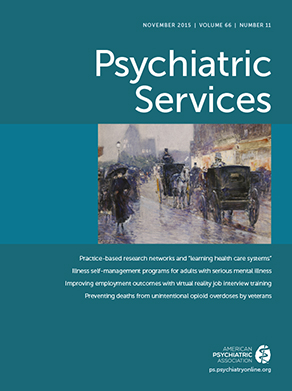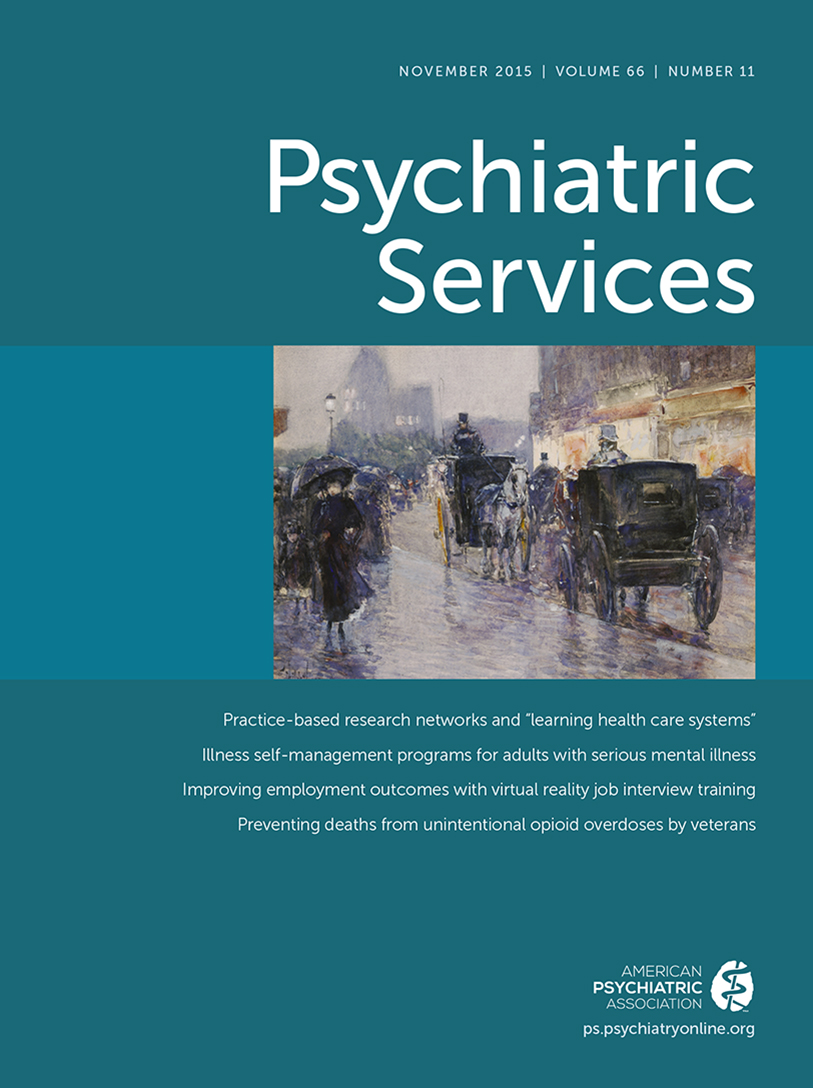Enormous national attention has focused on people with apparent mental illnesses who use guns to victimize strangers. Recent examples include incidents at Virginia Tech and the Washington Navy Yard and in Aurora, Colorado; Newtown, Connecticut; Tucson, Arizona; and Santa Barbara, California. These acts have important implications not only for potential victims but also for the public’s view of people with mental illness, for example, by increasing stigma and discrimination. They also have implications for the formation of mental health policy, for example, loosened standards for public reporting of protected health information or tightened standards for the possession and purchase of guns by persons with a mental illness (
1). In recent years, a great deal of research has dealt with violence by people with mental illness, but to date there has been limited attention to either gun violence by people with mental illness (
2) or violence against strangers by people with mental illness (
3). Previously unexamined data from the MacArthur Violence Risk Assessment Study provide what appears to be the first empirical information on gun violence directed at strangers by people who had been psychiatrically hospitalized.
Results
Of the 951 persons available for at least one follow-up, 262 (28%) committed at least one act of violence. A total of 608 violent acts were committed by these 262 patients.
Of the 608 violent acts, 178 (29%) were categorized as “weapon threat/weapon use.” In 67 (37%) of these incidents, the weapon was a gun; in 73 (41%) incidents, the weapon was a knife; in 19 (11%) incidents, the weapon—for example, a bat—was categorized as “other”; and in 19 (11%) incidents, the data were not known. The average time from discharge to an act of gun violence was 119 days.
The 67 acts of gun violence were perpetrated by 23 people, of whom 21 were males. Their median age was 24, and 61% were white. As shown in
Table 1, these 23 people were well known to both the mental health and criminal justice systems before the hospitalization during which they were recruited for the MacArthur Study. Only five of the 23 patients had no prior psychiatric hospitalizations, with a group average of 3.1 prior hospitalizations. Similarly, only two of the 23 patients had no prior arrests, with 12 patients having three or more prior arrests.
The 23 people with gun violence tended to have admission diagnoses of major depression (N=14, 61%), alcohol abuse (N=17, 74%), or drug abuse (N=12; 52%). Three patients (13%) were diagnosed as having bipolar disorder, none were diagnosed as having schizophrenia, and three (13%) received other diagnoses. At the time of hospital admission, the 23 people with gun violence displayed symptoms of substance abuse (N=14, 61%), suicidal threats (N=15, 65%), hallucinations (N=5, 22%), paranoia (N=3, 13%), delusions (N=2, 9%), and anxiety (N=2, 9%). Historical variables showed that 15 of the 23 (65%) had fathers who were arrested two or more times, and 21 (91%) had experienced serious abuse as a child.
For 558 of the 608 total violent acts (92%), the relationship of the victim and the discharged patient was known. In 77 (14%) of these 558 violent incidents, the victim was a stranger to the patient. These 77 acts of violence toward strangers were committed by 55 discharged patients.
Of the 558 violent incidents in which the relationship between the victim and the patient was known, 19 (3%) involved both a gun and a stranger as victim. The 19 gun-and-stranger incidents involved nine patients, representing 3% of the 262 patients who committed at least one violent act and 1% of the 951 patients with at least one follow-up.
All nine people who committed gun-and-stranger violence were males. With a median age of 23, they were approximately the same median age as the 23 patients with any gun violence. The percentage of whites (67%) was the same among perpetrators of gun violence toward a known victim and perpetrators of gun violence toward a stranger.
Like the patients who committed any gun violence (
Table 1), the nine patients who committed gun violence involving strangers were well known to both the mental health and the criminal justice systems. Eight had a prior mental hospitalization (mean=4.2 hospitalizations) and a record of prior arrests, and seven had three or more prior arrests.
The clinical profiles of the nine persons with gun-and-stranger violence were nearly the same as those of the entire group of 23 persons with any gun violence. These nine people tended to have admission diagnoses of major depression (N=5, 56%), alcohol abuse (N=8, 89%), or drug abuse (N=7, 78%). Two patients (22%) were diagnosed as having bipolar disorder, and none were diagnosed as having schizophrenia. At the time of hospital admission, the nine patients with gun-and-stranger violence displayed symptoms of substance abuse (N=6, 67%), suicidal threats (N=5, 56%), hallucinations (N=1, 11%), paranoia (N=1, 11%), and anxiety (N=2, 22%); none presented with delusional symptoms. Eight of the nine (89%) had fathers who had at least two arrests, and seven (78%) had been physically abused as a child.
Discussion
Of the 951 discharged patients available for at least one follow-up, 23 (2%) committed a violent act involving a gun, 55 (6%) committed a violent act involving a stranger, and nine (1%) committed a violent act that involved both a gun and a stranger as the victim. Violent acts that involved both a gun and a stranger as the victim constituted 3% of the 558 violent acts in which the relationship of the victim and the discharged patient was known.
The data presented here were subject to two important limitations. The first limitation was that the data were collected between 1992 and 1995 (
4,
5). In the past 20 years, patterns of admissions to civil psychiatric facilities, rates of violent crime, rates of incarceration in jails and prisons, and the prevalence of gun ownership have all changed. Were the MacArthur Study replicated today, the levels of gun violence toward strangers might differ—in an unknown direction—from those reported here. The second limitation was that the small size of the sample with gun violence or with strangers as victims precludes meaningful statistical analyses.
Keeping these two limitations in mind, the data suggest that the relatively few discharged patients who committed any gun violence, as well as the smaller subgroup of discharged patients who committed gun violence toward strangers, had more criminogenic risk factors than the great majority of discharged patients. Prior hospitalization rates among discharged patients who committed gun violence were comparable to those of the overall sample in the MacArthur Study (78% and 73%, respectively, among persons with at least one prior hospitalization) (
4). However, the prior arrest rate of discharged patients who later committed gun violence was almost twice as high as the prior arrest rate of the overall MacArthur sample (89%,
Table 1, and 49% [
4], respectively), with prior arrest rate defined as the proportion having at least one prior arrest.
None of the discharged patients who committed gun violence had an admission diagnosis of schizophrenia, compared with 20% of the overall MacArthur Study sample (
4). Rather, discharged patients who committed gun violence were more than twice as likely as the overall MacArthur Study sample to have an admission diagnosis of major depression (61% and 24%, respectively) (
4). Compared with the overall sample, discharged patients who committed gun violence were also much more likely to have an admission diagnosis of alcohol or drug abuse (78% and 37%, respectively) (
4).
These results are consistent with several other recent studies in emphasizing the overriding importance of criminogenic factors compared with psychotic symptoms as risk factors for violence among persons with mental illnesses (
6,
7). Such risk factors include prior arrests and alcohol and drug abuse. For example, Skeem and colleagues (
8), analyzing repetitive violence in the MacArthur data set, concluded that for the great majority (80%) of patients who committed two or more violent acts, psychotic symptoms never preceded the violent acts. For 15% of patients who committed two or more violent acts, psychotic symptoms sometimes preceded the violence and other times did not. For 5% of patients who committed two or more violent acts, psychotic symptoms always preceded the violence.
In addition, the levels of child abuse in this study are consistent with prior studies showing high rates of trauma in the criminal justice population (
9), and the role of childhood physical abuse, in combination with substance use, in subsequent violence is consistent with prior findings (
10). It is also worth noting that over half of the individuals with gun-and-stranger violence also had suicidal thoughts upon admission. This is important, given that persons with mental illness present a much higher risk of suicide, both generally and by gun, than of violence to others (
11). Risk management on an individual basis for discharged patients with these kinds of challenges, described elsewhere (
12), can be critical in maximizing safe discharge planning.

